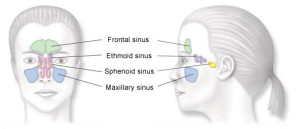Sinusitis Overview
Sinusitis affects 37 million people each year, making it one of the most common health problems in the U.S. It is more prevalent than heart disease and asthma and has a greater impact on quality of life than chronic back pain or congestive heart failure. Symptoms may significantly affect people physically, functionally, and emotionally.
The Role of the Sinuses
To understand sinusitis, it is important to first learn about your sinuses and their role with your health.
The sinuses are air spaces behind the bones of the upper face, between the eyes and behind the forehead, nose and cheeks. The sinuses are covered with a mucus layer and cells that contain little hairs on their surfaces called cilia. These help trap and push out bacteria and pollutants.
Each sinus has an opening that allows mucous to drain – this drainage is essential to keeping your sinuses working well and you healthy. Anything that obstructs that flow may cause a buildup of mucus in the sinuses and trigger symptoms that range from minor to severe.
Experts agree that healthy sinuses are a key to a good quality of life and that unhealthy sinuses may cause some unwanted complications.
Sinusitis Defined
Sinusitis is defined as an inflammation of the sinus lining commonly caused by bacterial, viral and / or microbial infections; as well as, structural issues such as ostial blockage. Symptoms include nasal congestion, facial discomfort, nasal discharge, headache, and fatigue.
Types of Sinusitis
There are two main categories of sinusitis: acute and chronic.
Sinusitis is usually preceded by a cold, allergy attack or irritation from environmental pollutants. Often, the resulting symptoms, such as nasal pressure, nasal congestion, a “runny nose,” and fever, run their course in a few days. However, if symptoms persist, a bacterial infection or acute sinusitis may develop.
Most cases of sinusitis are acute (or sudden onset); however, if the condition occurs frequently or lasts 12 weeks or more, you may have chronic sinusitis.
Facts About Sinusitis
- Sinusitis affects approximately 14% of the adult U.S. population.
- Sinusitis affects 17% of women and 10% of men each year.
- Chronic sinusitis (not including acute sinusitis) results annually in an estimated 18-22 million physician office visits.
- Direct healthcare expenditures due to sinusitis cost are well over $8 billion each year.*
- Sinusitis is also responsible for a significant loss of workplace productivity.
- Total restricted activity days due to sinusitis are well over 73 million per year.
* Inflation Adjusted
Sinus Symptoms
The symptoms caused by sinusitis may be quite uncomfortable. The signs and symptoms may include:
- Facial pain, pressure, congestion or fullness
- Difficulty breathing through the nose
- Discharge of yellow or green mucus from the nose
- Pain if the teeth
- Loss of the sense of smell or taste
- Headache
- Fatigue
- Sore throat
- Bad Breath
- Fever
- Coughing
Are my symptoms Sinusitis, Allergy or a Cold?
This chart will help you compare the symptoms of sinusitis with those of colds or allergies. If you suffer from three or more symptoms of sinusitis, you should see your doctor.
Left untreated, chronic sinusitis may lead to permanent damage to the sinus tissue.
|
SINUSITIS
|
ALLERGY
|
COLD
|
|
| Facial Pressure/Pain Duration of IllnessNasal Discharge Fever Headache Pain in Upper Teeth Bad Breath Coughing Nasal Congestion Sneezing |
Yes Acute: Over 10-14 days Chronic: 3 months Thick, yellow-green Sometimes Sometimes Sometimes Sometimes Sometimes Yes No |
Sometimes VariesClear, thin, water Thick No Sometimes No No Sometimes Sometimes Sometimes |
Sometimes Under 10 daysWhitish or thin Sometimes Sometimes No No Yes Yes Yes |
Source: http//www.entnet.org/Healthinformation/Sinusitis.ctm

